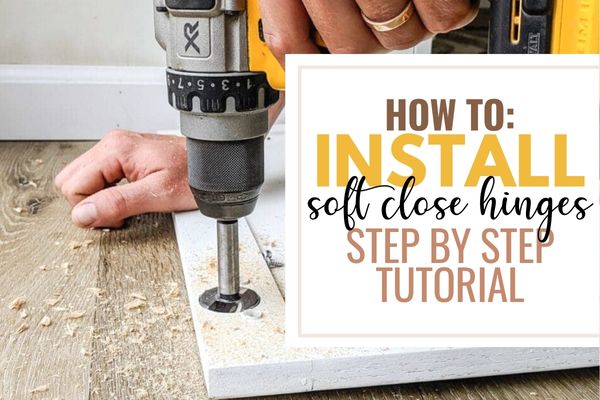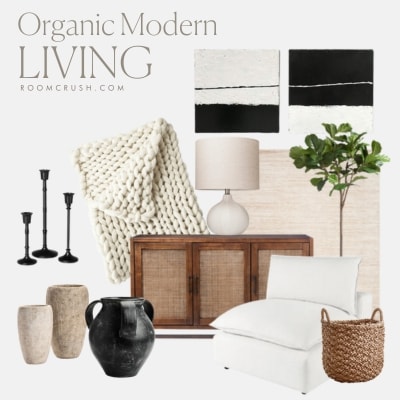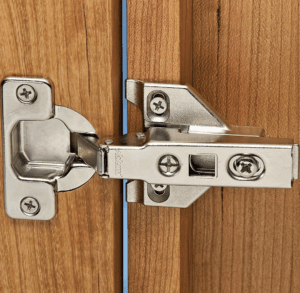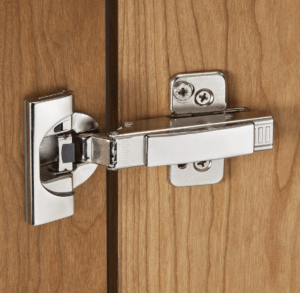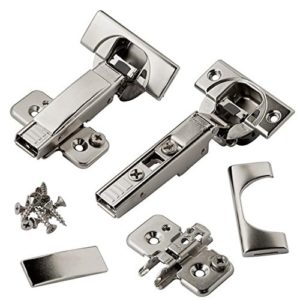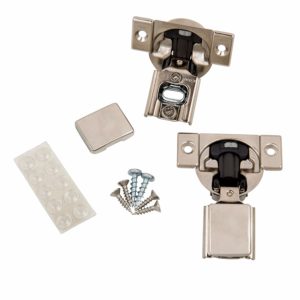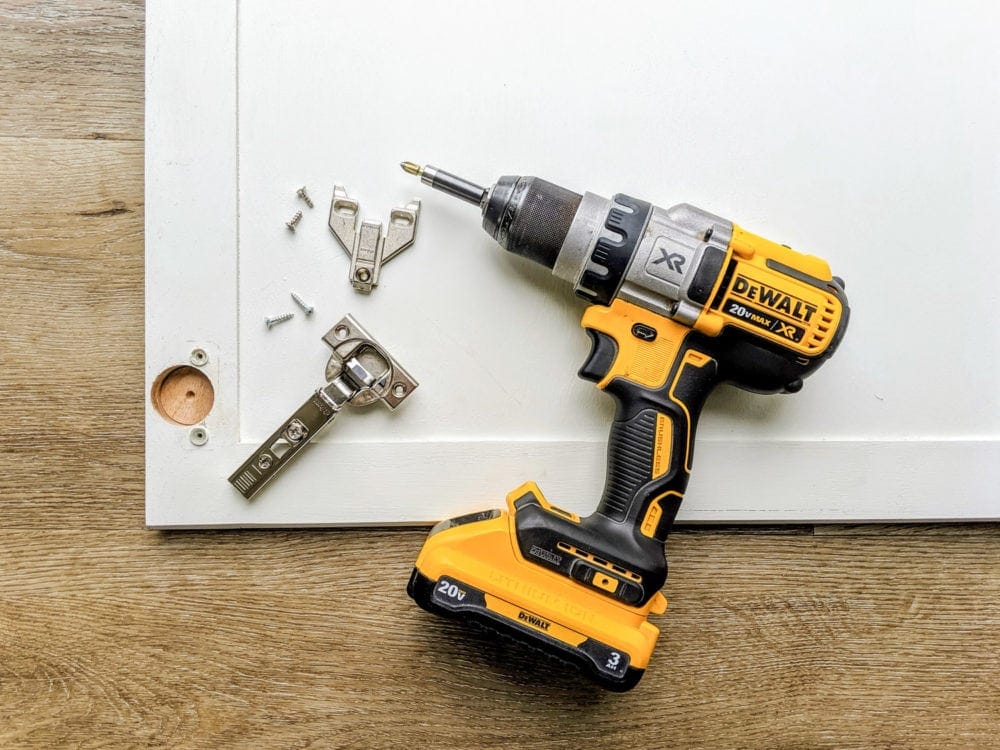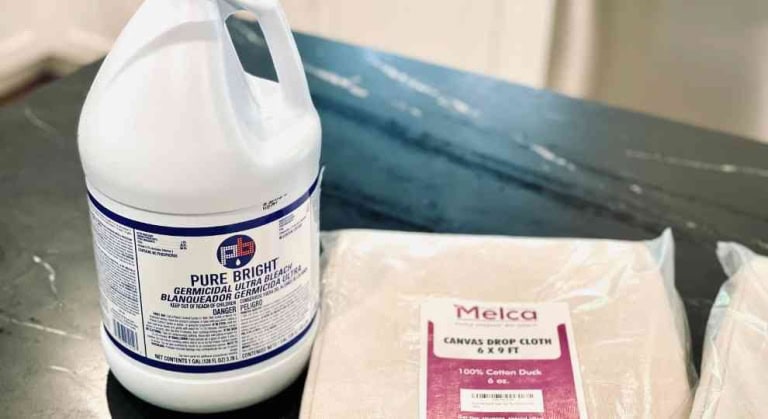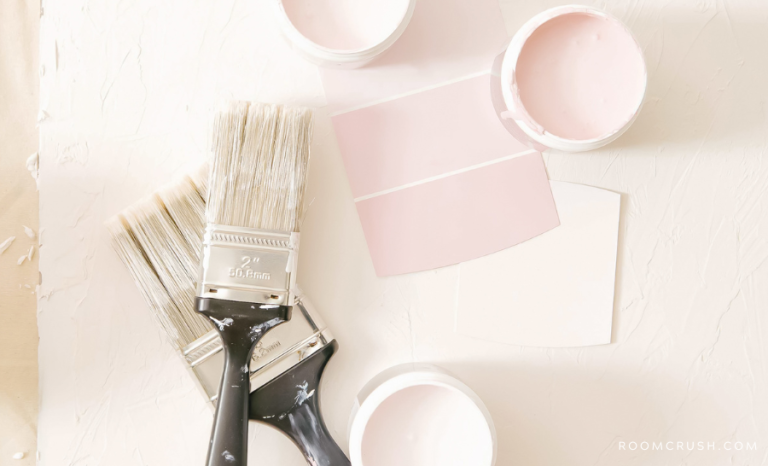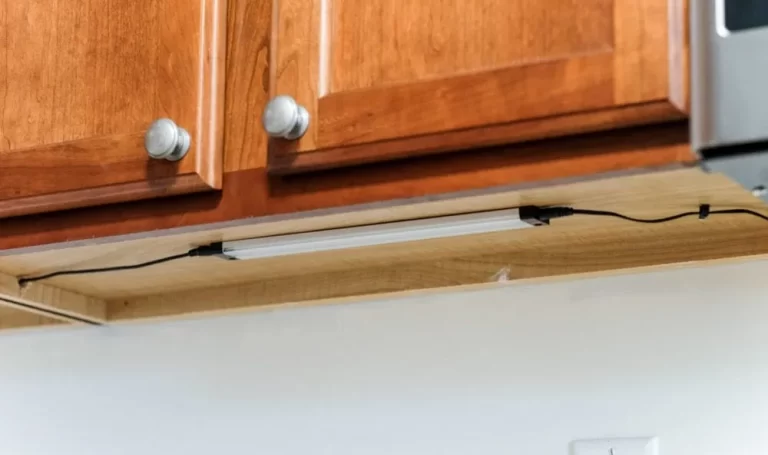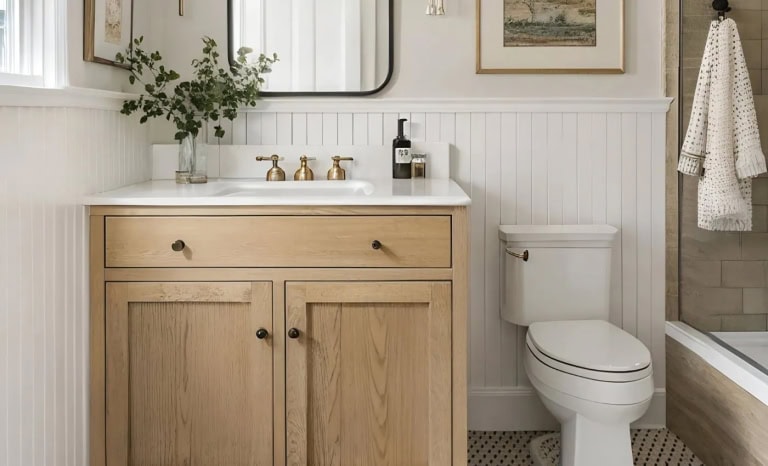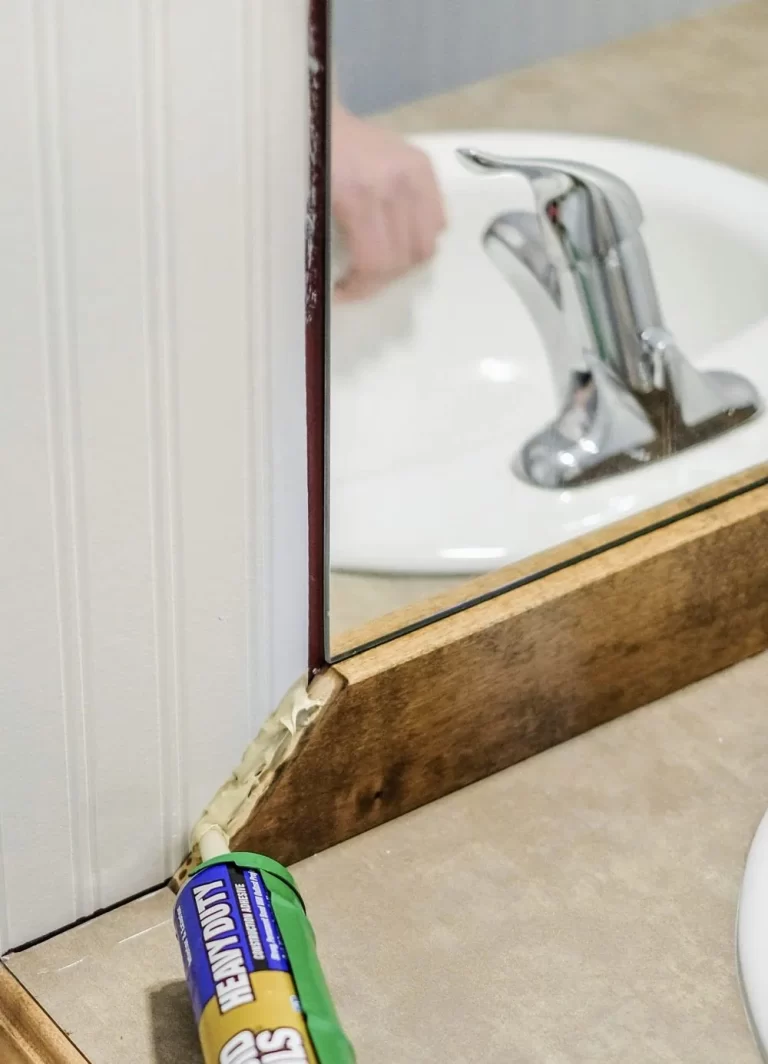How To Install Soft Close Hinges On Any Cabinet Door
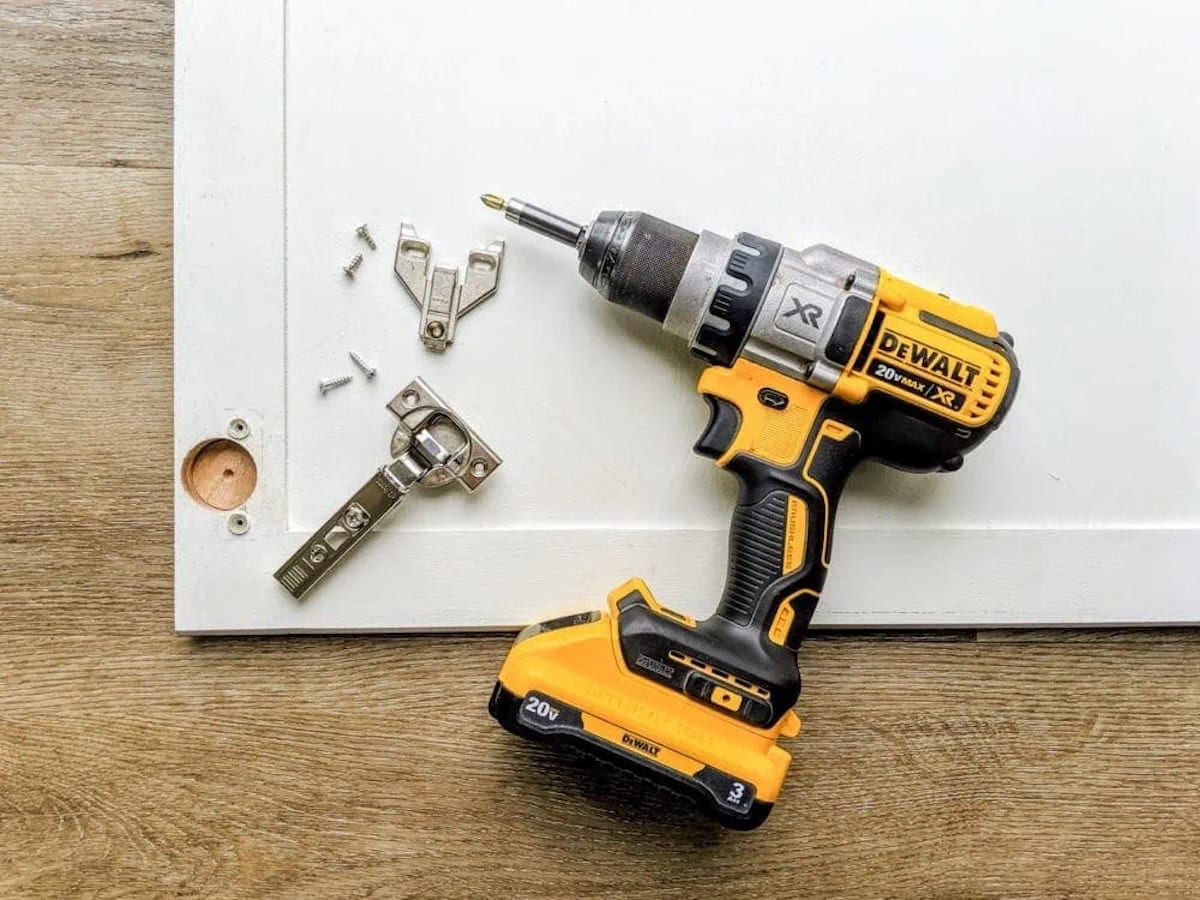
Adding soft close hinges to old cabinet doors is a kitchen upgrade that can can be accomplished in a weekend. This tutorial will show you how to install soft close hinges to existing cabinets and includes everything you need to know about choosing the right soft close hinges for your kitchen.
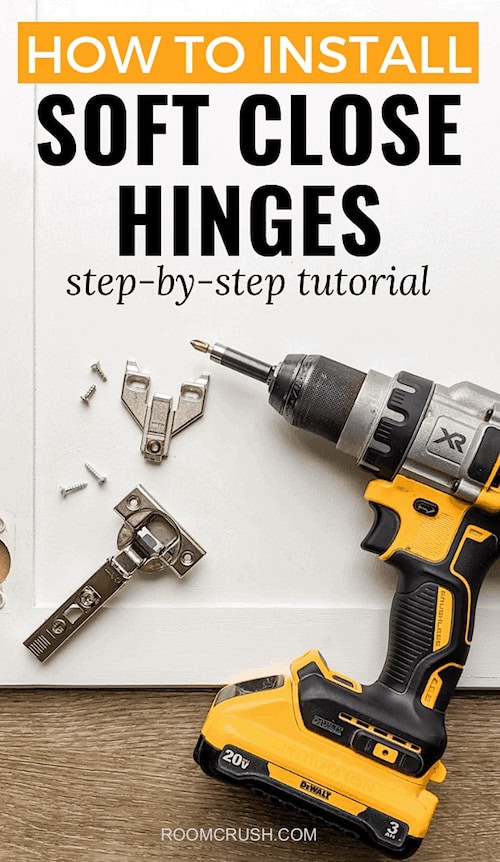
Most custom kitchens have soft close cabinets, and it’s such a nice feature! However, you don’t need a new kitchen, or custom cabinetry to upgrade to soft close hinges. Most cabinets can be easily upgraded to high quality soft close hinges, without breaking the bank.
Installing soft close hinges on existing cabinets is a relatively easy project that can can be accomplished in a weekend. Easy, affordable and a DIY? Yep! Keep reading to learn everything you need to know to replace your old cabinet hinges with soft close.
This site uses ads and affiliate content as an Amazon associate earning on qualifying purchases. Disclosure.
How do soft close hinges work?
Soft close hinges have a hydraulic damper built into the hinge. The damper prevents a cabinet door from slamming. It slows the door, and shuts it softly. These devices are also sometimes called self closing hinges. You can see the hydraulic damper inside the hinge in the image below.
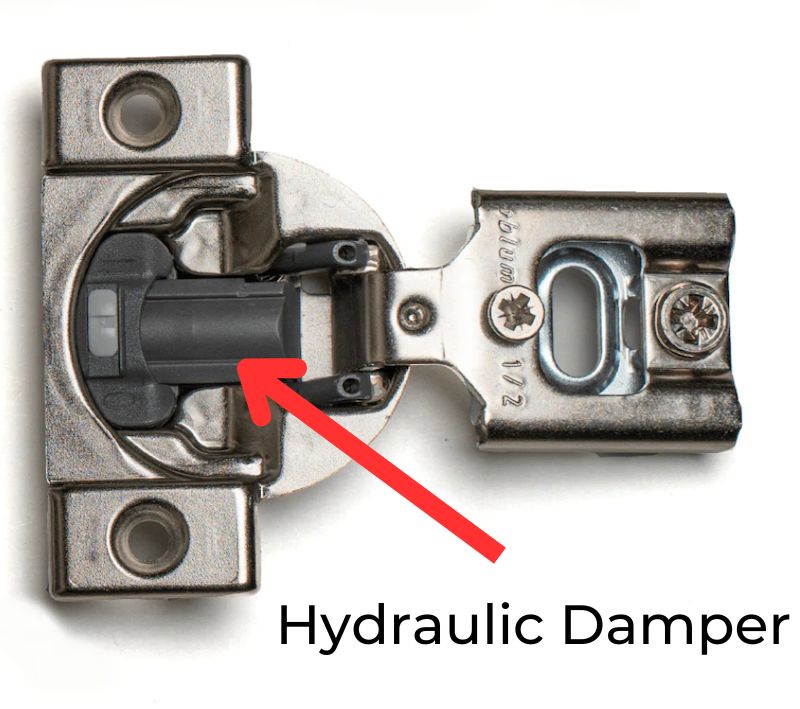
Can you add soft close hinges to existing cabinets?
Yes! You can make any hinge soft close. And it’s easier than you might think.
In this post I’ll walk you through exactly how to add soft close hinges to the existing cabinetry in your kitchen.
How much does it cost to add soft close to cabinets?
Upgrading your old cabinets to soft close hinges is a relatively fast and affordable project. Especially compared to the cost of most kitchen renovations.
There are a few different options when it comes to the actual soft close hinge hardware, as we’ll discuss in detail below, but generally you can purchase good quality soft close hinges for around $3.30 – $6.70 per hinge. Usually you can get a better deal when buying a larger quantity.
How do you turn regular cabinets into soft close?
Some projects are better left to the professionals, but I recommend giving soft close cabinet hinges a try yourself. All you need is a few basic tools and the right soft close hinge for your specific cabinets.
In fact, the most difficult part of this project is choosing the correct soft close cabinet hinges to work with your style of cabinetry. Once you’ve got that figured out, installation is easy!
This tutorial is designed to help you pick the proper hinge hardware that will be compatible with your cabinets, and then walk you through exactly how to install soft close hinges on your existing cabinets.
How To Install Soft Close Hinges On Any Cabinet Door
Choosing the right hinge for your cabinets is one of the most important steps! There are several styles of cabinets and doors which require unique hinges.
If you don’t use the proper style, it will not work with your cabinets. In the 3 steps below, I’ll give you all the information you need to confidently select soft close hinges that will work with your cabinets.
Before you can convert your existing cabinets to soft close, you’ll need to determine which soft close hinge you’ll need for your specific cabinet doors. Don’t worry, figuring this out is simple.
3 Easy steps to choose the correct soft close hinge for your cabinets:
Step 1: Identify your cabinet style.
The first step in picking the right hinge for your cabinets is to determine if you have face frame or frameless cabinets.
Face Frame Cabinets:
Most standard cabinets in the US are the face frame style. They’re called ‘face frame’ because a wooden frame is built onto the front of the cabinet. In this style of cabinets, the door hinges are fastened to the frame.
Below is a picture of a face frame cabinet: Notice how the hinge is fastened to a board on the front of the face frame cabinet.
Frameless Cabinets:
Frameless cabinets (also called European, Modern, or Flat Panel) have hinges that are fastened directly to the walls of the cabinet box.
Below is a picture of a frameless cabinet: Notice the hinge is fastened directly to the wall of the frameless cabinet.
Both of the above pictures use ‘hidden hinges’. They are called hidden hinges because they cannot be seen when the cabinet doors are closed.
Note: If you have exposed hinges, which can be see when the cabinet doors are closed, it is possible to convert to hidden hinges if you prefer the hidden style.
This conversion will require a few extra steps (which are addressed in detail below in the ‘How To Install Hinges’ section).
Step 2: Determine the style of your cabinet doors.
The second step in finding the right soft close hinge for your kitchen is to determine which style of cabinet doors you have. Use the illustrations below to identify which style of cabinet doors you have.
Are your cabinet doors: Standard, Full Overlay, or Inset?
Each of the 3 styles requires a unique soft close hinge design.
The pictures below will show you the difference between: full overlay, partial overlay (or standard), and inset cabinet doors.
Note: ‘Partial overlay’ cabinet doors are also known as ‘standard’. Partial overlay doors are the most common style in American cabinetry.
These illustrations show face frame cabinets, but the door function is the same with frameless cabinets. Just imagine the doors without the frame on the front of the cabinets.


Step 3: Choose a soft close hinge style.
Now that you’ve determined whether you have a face frame or frameless cabinets AND you’ve identified your cabinet door style, it’s time to select the specific soft close hinge style you want to use.
Compact Hinges or Long Arm Hinges?
This step is really a matter of preference, not compatibility. Both styles of hinges will work with your cabinets.
The choice is mostly related to price, quality, and performance. The pros & cons of both styles are listed below.
Important: No matter what style of hinge you choose, I strongly recommend choosing high quality cabinet hinges.
Here’s why… To help you decide which style is best for your soft close cabinet project, I wanted to find the best affordable products to recommend for this post.
So I started by testing several cheap soft close hinges from Amazon. But I found that all the inexpensive soft close hinges from Amazon felt…clunky.
They just didn’t seem to work well – at all.
They only seemed to work if you shut the cabinet doors gently, and they didn’t work well with larger, heavier doors. These cheap hinges were simply not the amazing upgrade I was hoping for, and honestly not worth my time.
Next, I tested some of the more professional brands that are used in high-quality cabinetry and… WOW! What a difference.
So trust me when I say, that choosing high-quality soft close hinges is very important!
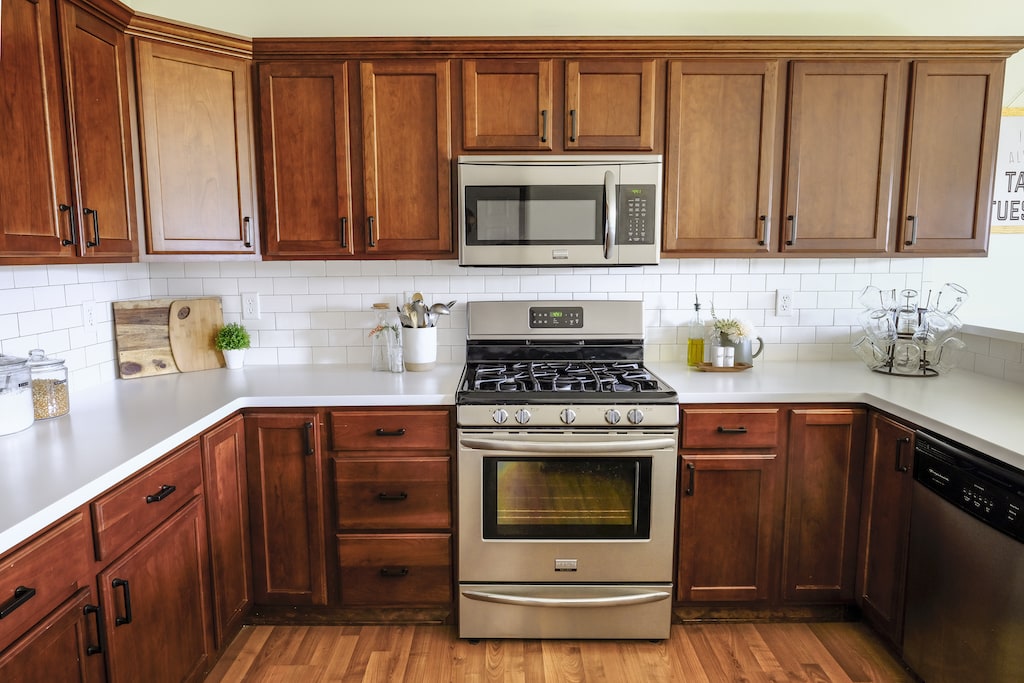
Related: How To Add Under Cabinet Lighting (in just 30 minutes!)
Best Soft Close Hinges: My Top Picks
I have recommendations from a few different price points that will still get you a great, high-quality hinge.
Option #1: Long Arm Hinges (Premium Option)
Long arm hinges are also sometimes called Euro or European-style hinges. They are strong, durable and accommodate a large robust hydraulic soft close mechanism.
In high-quality cabinetry, long arm hinges are typically used. Aside from being more expensive, the only downside of long-arm hinges is that they are physically larger and take up slightly more room inside of cabinets. Unless cabinet space is extremely limited, this will not matter much.
I tested several long-arm soft close hinges and found that some performed better than others. My biggest gripe with several of the hinges was the cabinets doors having noticeable resistance when opening.
This made using the cabinet doors slightly awkward. There were also hinges that seemed to be overpowered by larger doors and slammed shut, defeating the purpose of adding soft close hinges.
After all the testing, one brand stood out as a clear winner.
The winner: Blum Hinges.
All the Blum hinges excelled and seemed to work better than any other brands I tested. Particularly their BLUMOTION soft close hinges.
What is BLUMOTION?
The BLUMOTION hydraulic soft close mechanism is perfectly smooth and functions exactly how it was designed to. I recommend using these soft-close hinges. These Blum hinges are made in Austria and you can really feel the quality!
In my opinion, Blum hinges offer the best value because they aren’t super expensive, yet they have the best overall feel.
Best Soft Close Hinge Recommendation:
- Face Frame, Partial Overlay: Blum BLUMOTION Long Arm – Soft Close
- Frameless, Full Overlay: Blum BLUMOTION Long Arm – Soft Close
Note: These are the two most common hinge styles. Please follow the 3 steps under ‘Choose The Correct Hinge’ above to make sure you are getting the correct style of hinge to fit your cabinets.
Option #2: Compact Hinges (Budget Option)
Compact hinges are small, simple, and affordable. They work well but are not quite robust as premium long arm hinges. Depending on your budget for this project, compact hinges might be worth considering because they cost around half.
With compact soft close hinges, the hydraulic mechanism is smaller and fits inside of the hinge itself. This style has an inherent space constraint for the hydraulics and because of this, the performance suffers somewhat.
While I ended up going with the Blum BLUMOTION Long Arm hinge style, I tested Blum compact hinges on our cabinets to see if they were worth recommending – specifically the Blum BLUMOTION compact hinges. They were installed in our kitchen for about two weeks.
The soft close hinges functioned well, and still proved to be a pretty convenient upgrade compared to our old standard non-soft-close hinges. So if you’re looking for a cheaper option, the compact Blum hinges are a great choice!
The biggest downside associated with compact soft close hinges is slow recovery time.
Recovery time: the time that a cabinet door has to be open before the soft close mechanism is ready to function. If a hinge is closed before it is ‘recovered’, the soft close function will not work properly (or not work at all).
Having a slow recovery time means that if you quickly grab an item out of the cupboard and shut the door within 1 or 2 seconds, the hinge will not work properly and the door will slam shut like a regular old non-soft-close hinge. It’s honestly pretty annoying…
All the compact hinges we tested had relatively slow recovery times, but some were far worse than others. The times ranged from about 2 seconds to over 5 seconds! The Blum BLUMOTION compact hinge was the fastest recovering compact hinge.
For comparison: the Blum BLUMOTION Long Arm hinge have instant recovery. They work no matter what. This is why it is my top overall recommendation.
To learn more about Blum, you can check out their website for a full list of products and details.
Installing Soft Close Hinges On Existing Cabinets: Step-by-Step Tutorial
Installing soft close hinges on existing cabinets is a relatively easy project that can can be accomplished in a weekend.
Some projects are best left to the professionals, but this is the perfect kitchen upgrade for any DIYer with basic tools.
Here’s How to Install Soft Close Blum Hinges
It’s time for the fun part – installing your soft-close cabinet hinges! Follow this step-by-step tutorial for a quick and easy way to install soft close hinges on an existing cabinet door.
Tools & Supplies Needed:
Step 1: Remove Old Cabinet Doors & Hinges
Start by removing the cabinet door from the cabinet. Small wood screws are used to fasten the old hinges to the cabinet.
Most cabinetry will use screws that require a #2 Phillips bit to remove. Or a screw driver will get the job done as well.
Once the cabinet door is removed, take off the old hinges off of the cabinet doors.
Step 2: Drill A 35mm Hole (1 3/8″)
If your old cabinets had hidden hinges (also called concealed hinges) then there should already be a 35mm hole for the new hinges.
When converting to hidden hinges for the first time, you will need to drill new holes using a 35mm adjustable depth Forstner bit.
How do you measure cabinet doors for soft close hinges?
Cabinet doors that have existing holes should be measured to verify depth. Conventional non-soft-close hidden hinges are often shallow, so you may need to drill the hole deeper.
Follow the instructions that come with the specific hinge you buy. It will tell you how deep the 35mm hole needs to be drilled. For reference, the Blum hinges I installed required a minimum hole depth of 11.5mm.
You can use a jig for this step, but if you have a stead hand, it’s actually pretty easy to free-hand the drilling.
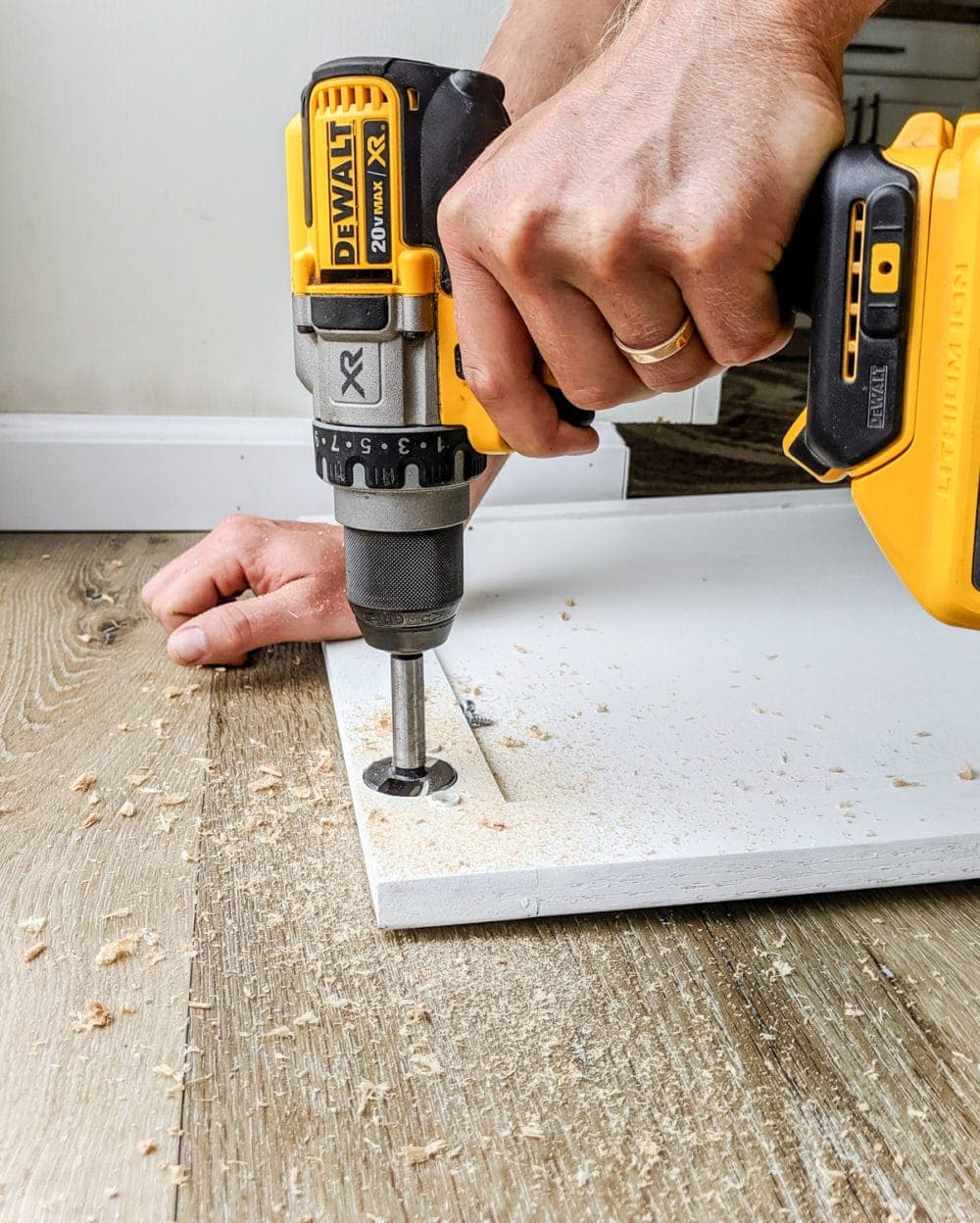
Step 3: Install Hinge Into Cabinet Door
Now that the old hinge has been removed, and the 35mm hole has been drilled to the proper depth, you’re ready to install the new soft close cabinet door hinges. This is a pretty easy step.
FAQ: Do you need 2 soft close hinges per door?
You can get away with only adding one soft close hinge per cabinet door, especially if budget is a concern. However, for best results, I recommend replacing both hinges.
With a properly drilled hole, the soft close hinge should drop into place with just a little coaxing. It will be a sung fit, but it should not require a ton of force do get it down into place.
You should be able to press the hinge down into the hole by hand. If the hinge is being stubborn, you can give it some gentle taps with a rubber mallet. If that doesn’t do the trick, the hole is probably not the correct size for your hinge.
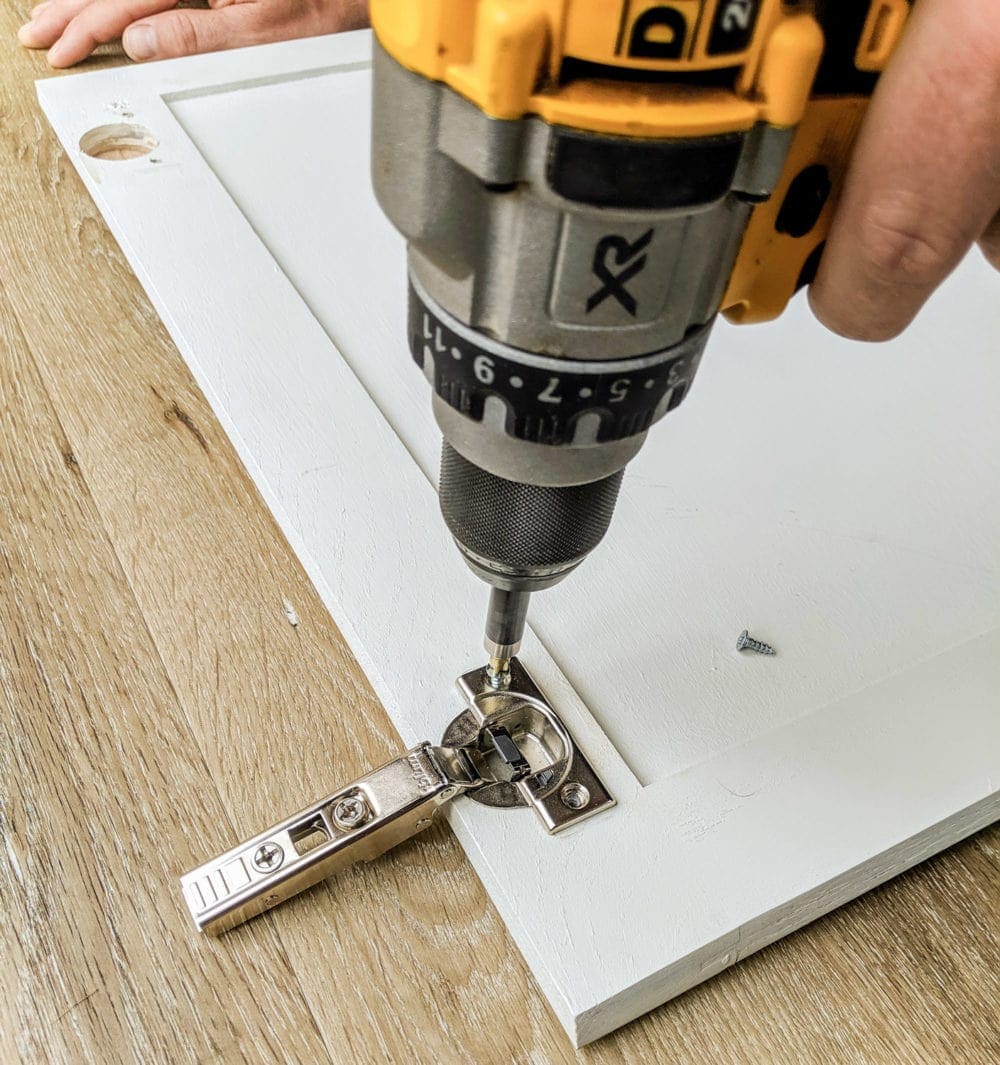
Make sure the soft close hinge is squarely in place, and flush with the top of the cabinet door. Once it is aligned properly, you can fasten it into place.
Use the small wood screws that are included with your hinges to attach it to your cabinet door.
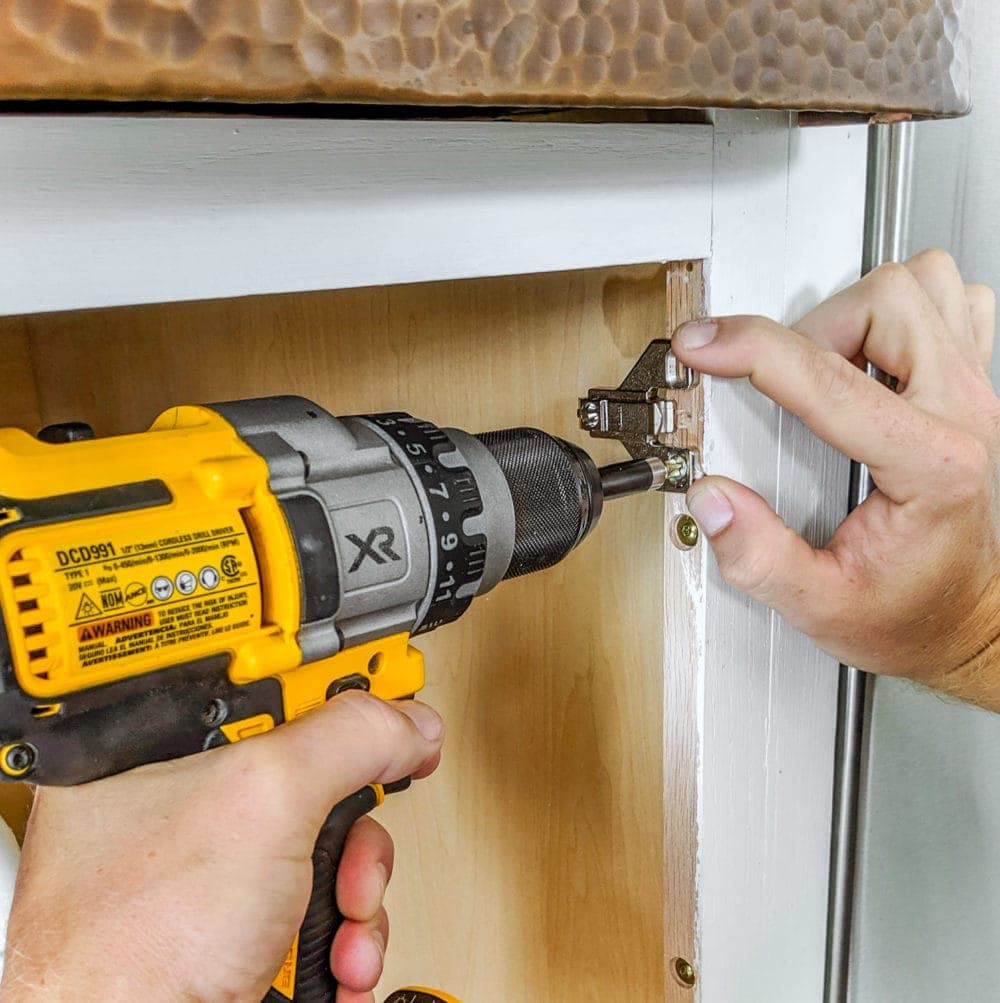
Step 4: Install Clip-On Mounting Plate
The next step is to install a mounting plate onto the cabinet. The picture above shows a mounting plate being installed to a face frame cabinet. The mounting plate is installed directly to the face frame.
It is called a ‘clip-on’ mounting plate because after installation, the cabinet door clips onto the mounting plate. This makes installation much easier compared to standard hinges where you have to hold the cabinet door in place while fastening the hinge to the cabinet!
Use the screw holes from the old hinges you removed to center the new mounting plate into the proper position on the cabinet. Before using a wood screw to fasten the mounting plate to the cabinet, pre-drill using a 5/64″ or 3/32″ drill bit to prevent the wood from cracking.
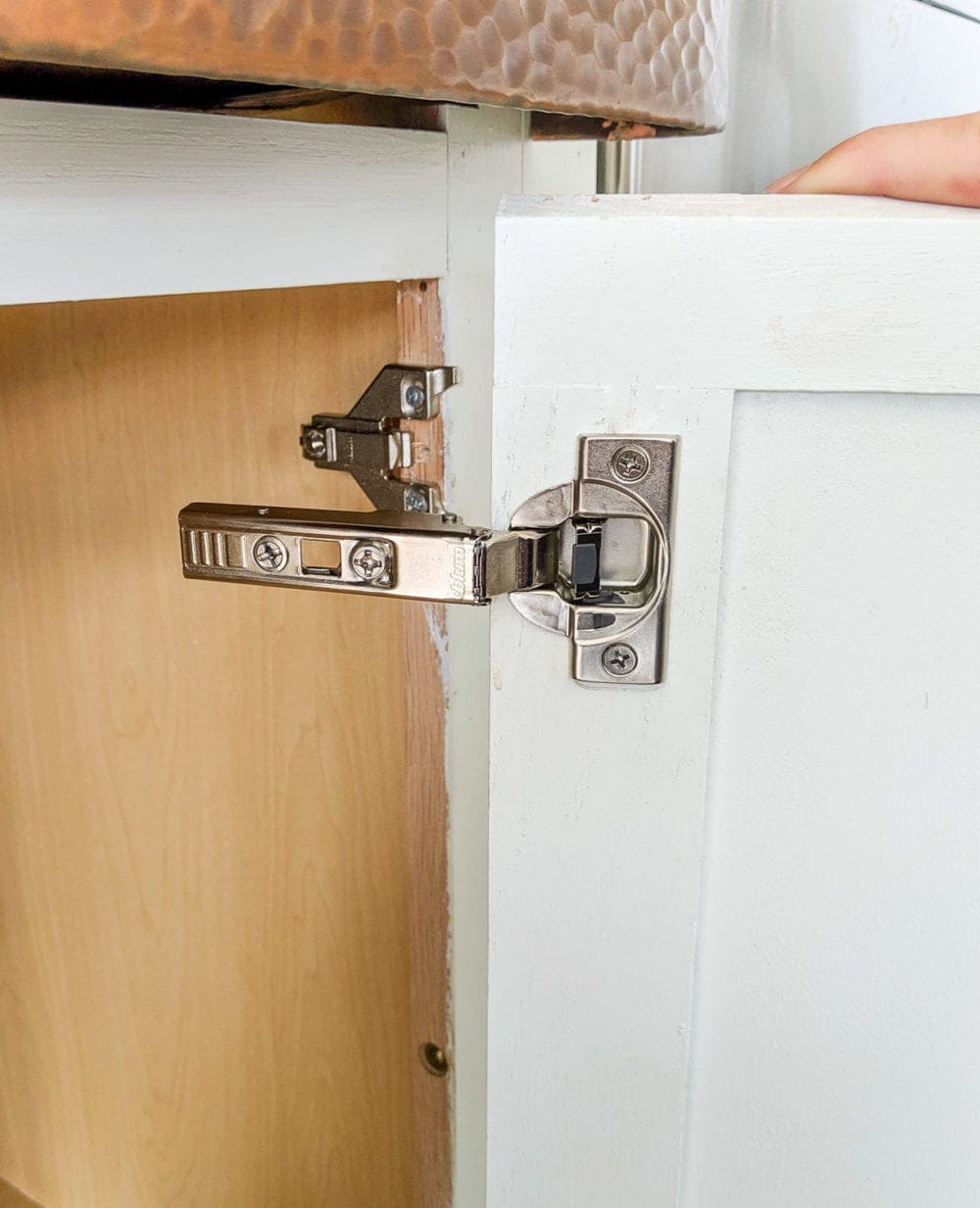
Step 5: Clip Hinges Into Mounting Plates
This is the easiest, and most satisfying step!
Hold the cabinet door with one hand, and one of the soft close hinges with the other hand. (With a large cabinet door, it may be useful to have a second person to help hold the door and guide it into place.)
Slide the soft close hinge into the mounting plate, and then push it into the plate to clip it into place.
If the hinges don’t line up perfectly with the mounting plates, you may need to loosen the screws on one, or both, of the mounting plates and adjust as needed.
Clipping the soft close hinges into the mounting plates should be easy as long as they are properly aligned.
Bonus: The cabinet doors can now be easily removed for cleaning, or any other reason. Simply slide them on and off the clip hinges.
Step 6: Test Out Your New Soft Close Hinges
Voila! You’re done.
Test out your new soft-close cabinet doors to make sure they are working properly, and then enjoy!
No more slamming cabinet doors, or worse, cabinet doors left ajar. (One of my wife’s biggest pet peeves.)
Tips For Success When Installing Soft Close Hinges
- Make sure to choose the proper style of hinge that is compatible with your specific cabinets.
- Choose a high-quality hinge that will offer a great user experience. Cheap hinges do not typically work well.
- Always use the proper PPE (personal protective equipment) and use safe practices when working with power tools.
- Use the correct tools, and precise measurements so that the cabinet doors will work properly, and line up perfectly with your cabinets.
- Be careful not to over-tighten the wood screws! It’s no fun dealing with stripped screws.
There you have it – everything you need to know about how to install soft close hinges to existing cabinet doors and which soft close hinges are the best for the job. I hope this helped you learn how to easily turn regular cabinets into soft close!
UP NEXT: How We Renovated Our Kitchen On A $10K Budget
Click the image below to pin this How to Add Soft Close Hinges to Old Cabinets post to refer back to later.
